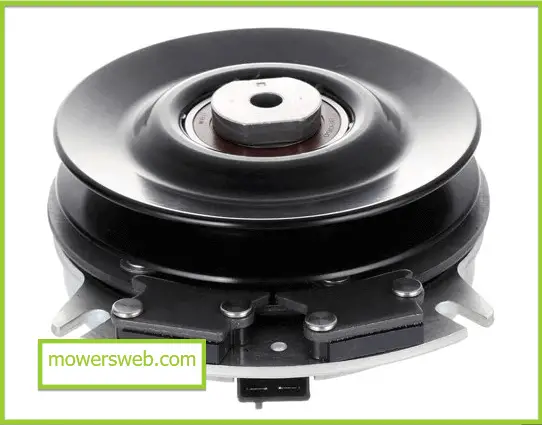Will a Bad PTO Clutch Cause Power Loss? Power loss in a vehicle can be frustrating, and it’s essential to understand the potential causes to address the issue effectively.
One component that can contribute to power loss is the Power Take-Off (PTO) clutch.
The PTO clutch is a crucial component in vehicles equipped with power take-off systems.
It engages and disengages power from the engine to auxiliary equipment, such as hydraulic pumps or generators.
In this post, we will explore the relationship between a bad PTO clutch and power loss, as well as discuss the symptoms, diagnosis, and potential solutions for this problem.
Let’s jump in.
Will a Bad PTO Clutch Cause Power Loss

Symptoms of Bad PTO Clutch
Identifying the symptoms of a bad PTO clutch is essential to accurately diagnosing power loss.
Some common indicators of a faulty PTO clutch include:
1. Unusual Noises
A worn-out or damaged PTO clutch may produce grinding, rattling, or squealing noises when engaged or disengaged.
2. Slipping Clutch
If the PTO clutch slips during operation, it can result in a loss of power to the auxiliary equipment.
3. Inconsistent Power Output
A faulty PTO clutch may cause inconsistent power delivery, leading to a decrease in performance.
4. Difficult Engagement
When the PTO clutch becomes stiff or challenging to engage/disengage, it may affect power transmission.
Power Loss and the PTO Clutch
A bad PTO clutch can contribute to power loss in multiple ways. The PTO clutch is responsible for transferring power from the engine to the auxiliary equipment.
If the clutch is not functioning correctly, it can result in a decrease in power output to the equipment, leading to power loss.
Read How to Remove PTO Clutch Bolt(In 5 Quick Steps)
Factors Affecting PTO Clutch Power Loss
1. Wear and Tear of the PTO Clutch
Over time, the friction plates in the PTO clutch can wear out, leading to reduced power transmission efficiency.
2. Misalignment Issues
Incorrect alignment of the PTO clutch with the engine can cause power loss and hinder proper engagement.
3. Faulty Clutch Engagement
If the clutch fails to engage fully, it can cause power loss or slip, affecting the performance of the auxiliary equipment.
4. Mechanical Problems in the Drivetrain
Issues like a damaged driveshaft or differential can result in power loss, which may be mistakenly attributed to the PTO clutch.
5. Electrical Issues
Problems in the electrical components of the PTO clutch, such as faulty wiring or switches, can disrupt power transfer.
Read How to Charge Toro Electric Start Mower(In 5 Steps)
How to Diagnose a Bad PTO Clutch
To determine if a bad PTO clutch is causing power loss, it’s important to perform a thorough diagnosis. Here are some diagnostic steps to consider:
1. Visual Inspection
Inspect the PTO clutch visually for any signs of damage, wear, or misalignment.
2. Listening for Unusual Noises
Pay attention to any abnormal noises, such as grinding or rattling, while engaging or disengaging the clutch.
3. Testing Clutch Engagement
Engage the PTO clutch and observe if it engages smoothly and remains engaged without slipping.
How To Fix a Bad PTO Clutch
If a bad PTO clutch is identified as the cause of power loss, several options are available to address the issue:
1. Clutch Adjustment
In some cases, a simple adjustment of the clutch linkage or cable may improve engagement and resolve power loss.
2. Clutch Replacement
If the PTO clutch is significantly worn or damaged, it may require replacement to restore proper power transmission.
3. Seeking Professional Assistance
Complex PTO clutch issues or those requiring specialized tools may necessitate professional help from a qualified mechanic.
Read 7 Toro V-Twin 708cc Engine Problems(With Solutions)
Preventive Maintenance for PTO Clutches
To minimize the occurrence of power loss due to a bad PTO clutch, regular preventive maintenance is crucial.
Here are some maintenance practices to follow:
- Regular Inspections: Perform routine inspections of the PTO clutch system to identify any signs of wear, damage, or misalignment.
- Lubrication: Ensure the clutch components are properly lubricated as per the manufacturer’s recommendations.
- Following Manufacturer Guidelines: Adhere to the maintenance schedule and guidelines provided by the vehicle and PTO clutch manufacturer.
Bad PTO Clutch Symptoms
| Symptom | Description |
|---|---|
| Difficulty Engaging/Disengaging | Resistance, grinding noises, or a hard-to-move lever when trying to engage or disengage the PTO. |
| Slipping | Connected equipment doesn’t receive expected power, resulting in reduced performance. |
| Abnormal Noises | Unusual sounds like grinding, squealing, or rattling when engaging or disengaging the PTO. |
| Vibration or Jerking | Vibrations or jerking motions in the equipment during PTO engagement. |
| Inconsistent Power Transfer | Intermittent power transfer leading to uneven or unexpected performance. |
| Burning Smell | A strong odor of burning due to excessive friction and heat from a slipping PTO clutch. |
| Decreased Performance | Overall reduction in power output or slower operation of the connected component. |
| Fluid Leaks | Possible fluid leaks around the PTO area, indicating a potential issue. |
Can a Worn Clutch cause Power Loss
Yes, a worn clutch can indeed cause power loss. The clutch is a crucial component that connects the engine’s power to the transmission, allowing for smooth gear changes and efficient power transfer to the wheels.
When the clutch is worn, it may not engage properly, leading to a reduction in power being transmitted from the engine to the drivetrain.
This can result in:
- Slippage: A worn clutch might not grip the flywheel and pressure plate effectively. As a result, when you accelerate, the clutch can slip, leading to a loss of power. This slippage wastes energy and prevents the full power of the engine from reaching the wheels.
- Inefficient Power Transfer: A worn clutch can hinder the smooth engagement of gears, causing the engine’s power to be transmitted less efficiently. This inefficiency can result in reduced acceleration and overall performance.
- Higher Revs: To compensate for the slipping clutch and maintain speed, you might need to rev the engine higher. This not only leads to poor fuel efficiency but also indicates that the clutch is not transferring power as it should.
- Delayed Acceleration: A worn clutch can cause a delay in power transfer when you press the accelerator. This delay can be particularly noticeable during quick acceleration or overtaking situations.
- Stalling: In extreme cases, a worn clutch might struggle to fully engage or disengage, causing the vehicle to stall when starting from a stop or changing gears.
Read Kubota SVL75-2 Losing Power(5 Quick Ways To Fix)
Final Remarks
A bad PTO clutch can cause power loss in a vehicle with a power take-off system.
Understanding the symptoms, diagnosing the issue accurately, and taking appropriate measures for repair or replacement are essential steps to address power loss caused by a faulty PTO clutch.
Regular maintenance and adherence to manufacturer guidelines can help prevent such issues from arising.
Read Low Oil Symptoms in Lawn Mowers (Don’t Ignore These Signs)
FAQs
How long does a PTO clutch last?
The lifespan of a PTO clutch depends on various factors, including usage, maintenance, and operating conditions. On average, a well-maintained PTO clutch can last for several years.
Can I still drive my vehicle with a bad PTO clutch?
It’s not recommended to drive a vehicle with a bad PTO clutch, as it can lead to further damage and safety risks. It’s best to address the issue promptly.
Why is the PTO clutch slipping?
Wearing friction plates, insufficient clutch adjustment, or issues with hydraulic pressure can all be the root of a slipping PTO clutch. It requires inspection and appropriate repairs.
Are all power losses related to the PTO clutch?
No, power loss in a vehicle can have various causes, including engine-related issues, drivetrain problems, or electrical faults. Proper diagnosis is crucial to accurately identify the root cause.
What happens if I ignore a bad PTO clutch?
Ignoring a bad PTO clutch can result in further damage to the clutch system, decreased performance of auxiliary equipment, and potential safety hazards. It’s advisable to address the issue promptly.




